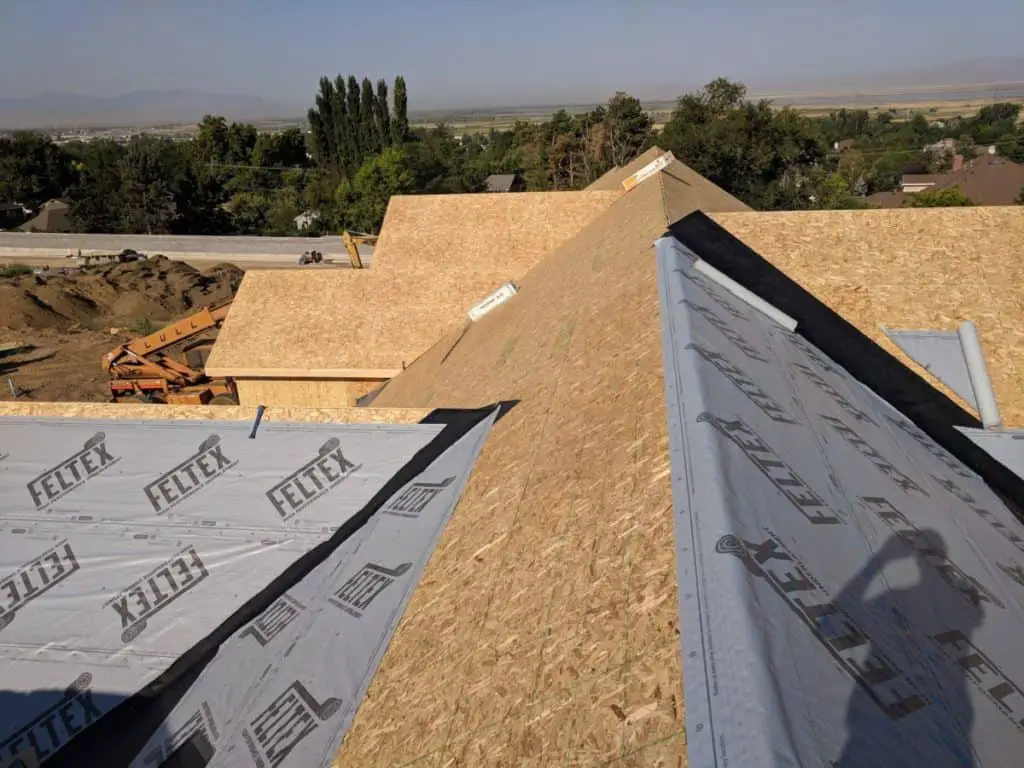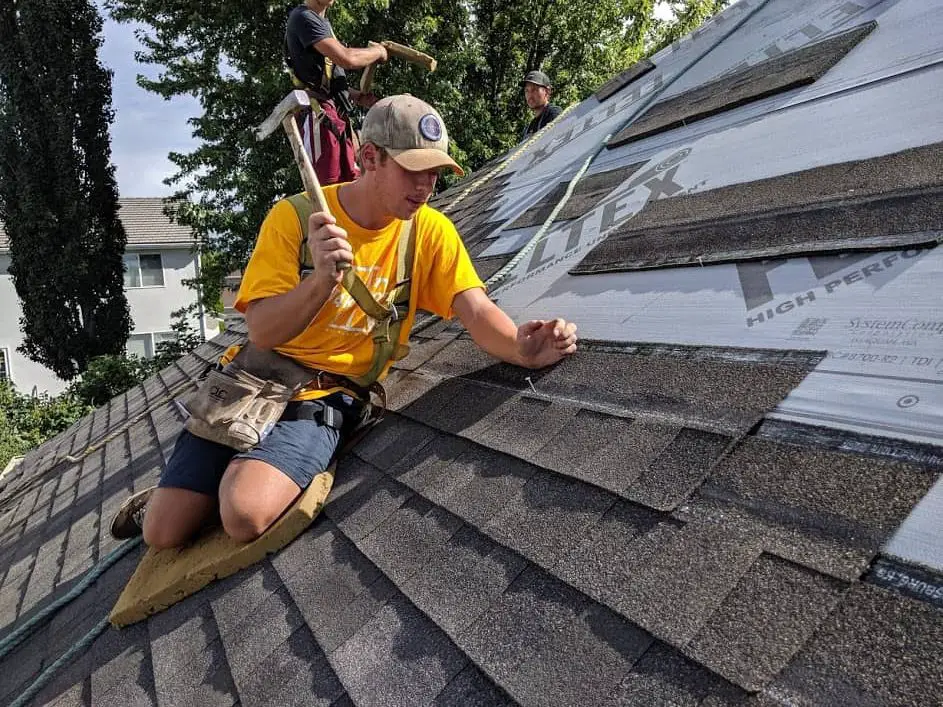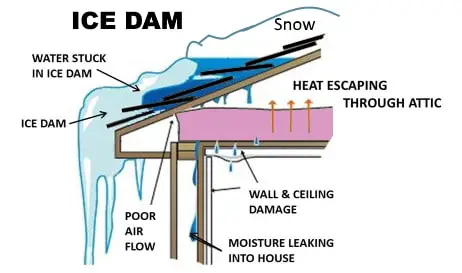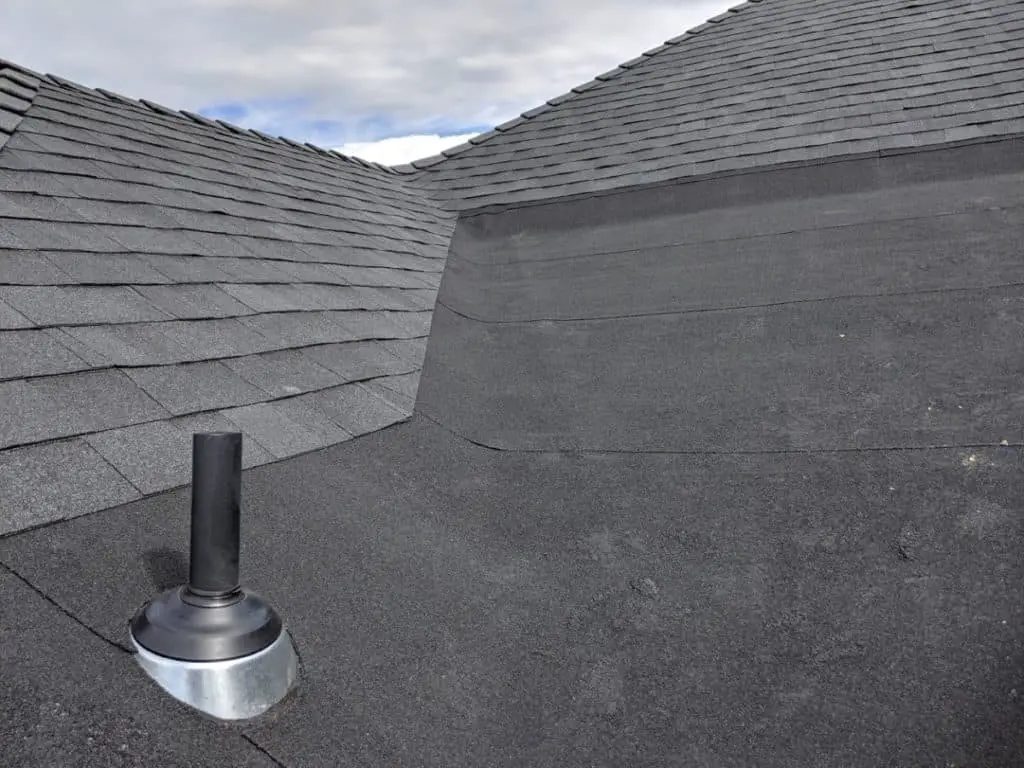
The roof of your home consists of various layers, each with a different role crucial for an efficient roofing system. Namely, the wood decking, the dry-in layer, and lastly the shingles. The dry-in layer consists of felt plus ice and water shield. If you are doing your own roof you may be wondering does roofing felt go over or under ice and water shield?
Does Roofing Felt Go Over Ice and Water Shield? The quick answer is yes, roofing felt does get installed over ice and water shield. The answer to this question and many more questions can be found using the water principle.
This is something I was taught when I was first learning how to roof. Think of it like this, when water lands on top of your roof, it’s always going to run downwards.
This means that with everything you do on the roof you should ask yourself which way is water going to run. Water runs downwards so many things will be layered to accommodate for this.
In this example, you can see that the metal flashing is layered in such a way to account for the flow of water.

You can see the same principle is applied to the shingles. The water principle can also be applied to ice and water shield and felt.

If you need ice and water shield, you should first start at the bottom edge of the roof. (this is of course after you have installed drip edge). With each consecutive layer of ice and water shield, or roofing felt you should layer it above the previous row with about 3 inches of overlap to account for the flow of water.

The amount of ice and water shield rows needed is dependent on your local climate and building code specs. Where I am from, we get snow in the winter so we are required to install at least 1 row of ice and water shield. The rest can be synthetic felt. Other places may require 2 rows of ice and a water shield before felt can be installed.
When applying ice and water shields, it is crucial to work on a clean and dry roof deck. The installation should begin by carefully aligning one length of ice and water shield at the installation area. The shield should be pressed to the roof deck’s surface as you peel the paper to expose the sticky adhesive.
Keep in mind if it’s warm outside the back of the surface can get very sticky and become difficult to lay down even with 2 people. If it’s warm out, and you remove the back peel, don’t let the back peel touch the sticky surface a second time. If it does, it will get stuck to it and will become frustratingly difficult to remove again.
To avoid this issue, we ususally install the ice and water shield during the cool hours of the morning. I have found it makes it much easier to install during this time.
A professional roofer should know how much to install in your local area. I recommend finding a professional roofing contractor through our trusted partner Home Advisor because they allow you to get up to 4 quotes for free. This allows you to compare and choose the best roofing professional for your needs. Check them out by using this affiliate link.
Ice and water shields are also commonly installed on complex parts of the roof or in places where there needs to be extra water protection. This includes valleys, skylights, dormers, pipe flashings, or chimneys. As previously mentioned, local building codes, the climate in your area, and the pitch of your roof all contribute to determining whether ice and water protectors are needed or not.
Some people may request to cover their entire roof in ice and water shield. I do not recommend this because it is expensive, can cause ventilation problems, and makes it much more difficult to remove the shingles the next time you need a roof replacement.
What is Ice & Water shield? What is it made of? What is the purpose of it?
Throughout the winter season, water cycles between melting and freezing. This cycle actually causes ice to travel up the roof underneath the shingles. Ice and water shield helps to protect against this.

Essentially, ice and water shield is a roofing product that is self-adhering and waterproofing, used to prevent damage caused by ice dams and wind-driven rain.
It is comprised of asphalt cement, a special stretchable membrane, and butadiene styrene (a type of copolymer).
Ice and water shield products are used anywhere on the roof, where water tends to collect and flow, like the eaves and rakes, valleys, flashings, and chimneys. A product like this is applied to these vulnerable areas to avoid water seeping under the roof and doing damage.

What areas of the roof need to be covered in ice and water shield?
Ice and water shields are sometimes recommended or mandatory to be installed over the entire roof if you live in a region where the risk of ice dams or wind-driven rain is severe or if you have a roof slope lower than 4:12.
However, ice and water shield is most commonly installed by roofing professionals over eaves, rake edges, overhangs and valleys. These areas tend to be the most vulnerable to ice dams and wind-driven rain. In some cases, the jurisdictions’ building code will determine which areas need ice and water shield coverage.
It is also wise to install ice and water protectors beneath the flashing of vent stacks and chimneys if the shingles in these areas overlap entirely. If you have a feature that penetrates the roof deck, like dormers and skylights, it can be beneficial to apply an ice and water shield in these areas as well.
What are the different types of Ice & Water shield?
Ice and water shields are made in a specific way, and therefore, all product brands are made with polymer-modified bitumen. Furthermore, the membrane has an adhesive back surface that bonds to the roof deck. These shields are all designed in such a way to form a watertight seal around the nail penetrations when shingles are applied.
Ice and water shield are available in several different brands, including Grace, WeatherLock, Weather Watch, Moisture Guard Plus, and more.
Grace Ice & Water Shield is considered to have the best adhesion to the roof deck, making it an outstanding product. These ice and water shields come in various sizes and types to fit different kinds of roofing materials.
What are the different types of roofing felt options out there?
Asphalt-saturated felt, rubberized asphalt, and non-bitumen synthetic roofing felt are some of the most basic types of underlayment used beneath roofing materials.
One can say that felt originated from the century-old tar paper, which is heavy-duty paper impregnated with tar. A modern version of tar “felt” is asphalt felt, impregnated with asphalt instead of tar.
If one were to compare synthetic underlay with regular felt underlay, one would notice that synthetic felt is much lighter, which will add less weight to the roof. Synthetic underlayment is also much more tear-resistant when exposed to high winds than asphalt felt underlayment.
It is easy to confuse ice and water shields with felt paper as the two look similar. However, ice and water shields are vastly different in performance and a far more superior product than traditional felt. Ice and water shield need to be installed before other underlayments, including roofing felt.
Tar paper compared to ice and water shield do not stick to anything, whereas ice and water shields are a rubberized membrane that is very sticky to create a waterproof barrier to standing water if installed correctly.
What type of felt is the best?
There are various roofing felt products on the market that offer superior quality. The most popular types of roofing felt to choose from are asphalt, and rubberized roofing felt. The rubberized felt is the modernized version and a more expensive type, which tends to be more waterproof than traditional roofing felt. Therefore one can say that rubberized felt is more durable. However, this does not mean that conventional felt does not do the job correctly.
Either way, the type of roofing felt that is best for you will depend on your situation. It is always best to contact a professional if you are not sure.
When choosing the best durable roofing felt, it is essential to choose the right weight. For instance, if your rooftop has a slope of 4:12 or higher, then a single layer of 15-pound roofing felt would be ideal. In the case of a lower pitch, one would generally need a double layer or weightier felt.
In areas that get snowfall or heavy winds, heavier felt or extra layers are recommended. Remember that roofing felt of 15 or 30 pounds will give adequate protection; however, some roofing materials will require heavier weights.
Additional Questions:
Is ice and water shield necessary?
Ice and water shields are needed for your roof if you want to add an extra layer of protection. It is unnecessary to cover the entire roof with these protectors, especially if you have a roofing underlayment installed. However, it is wise to have ice and water shields installed on the roof areas where water seepage is a common problem.
Can you reuse ice and water shields?
Unless you are buying an ice and water shield knock-off, you will have a pretty tough time removing it from the roof deck. If you do get to remove the ice and water shield without much damage, then the adhesive side most probably won’t have the same quality to it anymore. Therefore it is best to simply buy a new ice and water shield to ensure high quality.
Can ice and water shield be installed over shingles?
The ice and water shield’s purpose is to protect the deck of the roof and prevent water from coming into the structure. If you put an ice and water shield over old shingles, you will waste time and money as it will only protect the old shingles.

